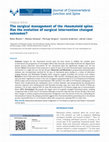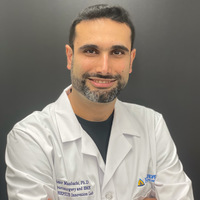Papers by Nikolaos Haliasos
The Lancet Regional Health - Europe

BackgroundIn Essential tremor (ET), involuntary shaking of the upper limbs during isometric muscl... more BackgroundIn Essential tremor (ET), involuntary shaking of the upper limbs during isometric muscle contraction closely reflects the patterns of neural activity measured in the thalamus - a key element of the tremorgenic circuit. Phase-specific deep brain stimulation (DBS) builds upon this observation while using accelerometery of the trembling limb to trigger repetitive electrical perturbations to the thalamus and surrounding areas at a specific time within the tremor cycle. This closed-loop strategy has been shown to induce clinically significant postural tremor relief while delivering less than half the energy of conventional DBS.ObjectiveThe main aim of the study was to evaluate treatment efficacy across different contexts and movement states.MethodsWe used accelerometery and a digitizing tablet to record the peripheral tremor dynamics of 4 DBS implanted ET patients while alternating stimulation strategies (no stimulation, continuous open-loop and phase-specific) and movement sta...

Current Pharmaceutical Design, 2018
BACKGROUND Antiepileptic treatment strategy plays an important role in the management of intracra... more BACKGROUND Antiepileptic treatment strategy plays an important role in the management of intracranial vascular malformations. The intracranial vascular malformations can be divided into cavernous hemangiomas, arteriovenous malformations, developmental venous anomalies and capillary telangiectasias. Seizures and hemorrhage are among their most common clinical manifestations. OBJECTIVE The aim of this article is to review the current literature on the antiepileptic treatment in the setting of intracranial vascular malformations and offer an updated view on when antiepileptic drug treatment should be employed for each type of vascular malformation. METHODS AND MATERIALS Current literature has been reviewed on cavernous malformations, arteriovenous malformations, developmental venous anomalies and capillary telangiectasias. Epidemiological features, epileptogenesis, clinical presentation and antiepileptic treatment have been analyzed. RESULTS A variety of treatment modalities exist for the management of intracranial vascular malformations, including antiepileptic treatment, microsurgery, radiosurgery and embolization. The decision-making process is different for each type of intracranial vascular malformation. Moreover, a plethora of other clinical factors needs to be taken into consideration during the decision-making process, such as the patient's age and comorbidities, the risk of hemorrhage the need for definitive treatment of the malformation, the seizure rates after the definitive treatment, the efficacy and side effects profile of antiepileptic drugs. CONCLUSION Antiepileptic treatment strategy is a multifactorial decision that should be individualized and ideally be made by multidisciplinary teams.

Emergency Medicine Journal, 2020
ObjectiveWe report the utilisation and impact of a novel triage-based electronic screening tool (... more ObjectiveWe report the utilisation and impact of a novel triage-based electronic screening tool (eST) combined with clinical assessment to recognise sepsis in paediatric ED.MethodsAn electronic sepsis screening tool was implemented in the paediatric EDs of two large UK secondary care hospitals between June 2018 and January 2019. Patients eligible for screening were children < 16 years of ages excluding those with minor injuries or who were brought directly to resuscitation. Subsequently, a retrospective evaluation was performed to determine the performance of the tool alone and in combination with clinical assessment after triage, to identify septic patients, using sensitivity, specificity, positive, negative predictive values (PPV and NPV) and likelihood ratios.Results19 912 children were triaged during the study period, of whom 90 (0.45%) were classified as having sepsis. 99% of all eligible patients were screened. The eST alerted for 2651 (13.3%) patients. After immediate phys...
Movement Disorders Clinical Practice, 2021
Deep brain stimulation (DBS), levodopa‐carbidopa intestinal gel (LCIG) and subcutaneous apomorphi... more Deep brain stimulation (DBS), levodopa‐carbidopa intestinal gel (LCIG) and subcutaneous apomorphine infusion are device‐aided therapies (DATs) for advanced Parkinson's disease (PD). We present a case series from the Cretan PD Registry who required 2 DATs for optimal management along with a systematic review of similar studies.

Current pharmaceutical design, 2017
Surgery for epilepsy dates back to 1886 and has undergone significant developments. Today it is c... more Surgery for epilepsy dates back to 1886 and has undergone significant developments. Today it is considered a key treatment modality in patients who are resistant to pharmacological intervention. It improves seizure control, cognition and quality of life. New technologies, advances in surgical technique and progress in scientific research underlie the expansion of surgery in epilepsy treatment. Effectiveness of surgical treatment depends on several factors including the type of epilepsy, the underlying pathology and the localisation of the epileptogenic zone. Timely referral to an experienced epilepsy surgery centre is important to allow the greatest chance of seizure control and to minimise associated morbidity and mortality. Following referral, patients undergo thorough presurgical investigation to evaluate their suitability for surgery. The commonest form of epilepsy treated by surgery is mesial temporal lobe sclerosis and there is Class I evidence for the medium-term efficacy of ...

Trials, 2018
Background: Chronic subdural haematoma (CSDH) is a common neurosurgical condition, typically trea... more Background: Chronic subdural haematoma (CSDH) is a common neurosurgical condition, typically treated with surgical drainage of the haematoma. However, surgery is associated with mortality and morbidity, including up to 20% recurrence of the CSDH. Steroids, such as dexamethasone, have been identified as a potential therapy for reducing recurrence risk in surgically treated CSDHs. They have also been used as a conservative treatment option, thereby avoiding surgery altogether. The hypothesis of the Dex-CSDH trial is that a two-week course of dexamethasone in symptomatic patients with CSDH will lead to better functional outcome at six months. This is anticipated to occur through reduced number of hospital admissions and surgical interventions. Methods: Dex-CSDH is a UK multi-centre, double-blind randomised controlled trial of dexamethasone versus placebo for symptomatic adult patients diagnosed with CSDH. A sample size of 750 patients has been determined, including an initial internal pilot phase of 100 patients to confirm recruitment feasibility. Patients must be recruited within 72 h of admission to a neurosurgical unit and exclusions include patients already on steroids or with steroid contraindications, patients who have a cerebrospinal fluid shunt and those with a history of psychosis. The decision regarding surgical intervention will be made by the clinical team and patients can be included in the trial regardless of whether operative treatment is planned or has been performed. The primary outcome measure is the modified Rankin Scale (mRS) at six months. Secondary outcomes include the number of CSDH-related surgical interventions during follow-up, length of hospital stay, mRS at three months, EQ-5D at three and six months, adverse events, mortality and a health-economic analysis.
Stereotactic and Functional Neurosurgery, 2015

Journal of neurological surgery. Part B, Skull base, 2014
Background Improved treatment and survival of patients with skull base tumors has made the assess... more Background Improved treatment and survival of patients with skull base tumors has made the assessment of quality-of-life (QoL) in this population increasingly important. This article provides a comprehensive systematic review pertaining to QoL assessment in adults undergoing anterior skull base surgery. Methods We performed a literature search using the electronic databases of Ovid Medline and Embase. Additional articles were identified through a search using the phrase anterior skull base. Further articles were sought through hand-searching relevant journals and reference lists of identified articles. Results Our search strategy identified 29 articles for inclusion in our systematic review, with considerable variation between studies in population characteristics, methodological design and quality, follow-up length, and outcome assessment. The most commonly used QoL tools were the Karnofsky Performance Status and the Anterior Skull Base Questionnaire. QoL following anterior skull b...

Journal of Craniovertebral Junction and Spine, 2014
Context: Surgery for the rheumatoid cervical spine has been shown to stabilize the unstable spine... more Context: Surgery for the rheumatoid cervical spine has been shown to stabilize the unstable spine; arrest/improve the progression of neurological defi cit, help neck pain, and possibly decelerate the degenerative disease process. Operative intervention for the rheumatoid spine has signifi cantly changed over the last 30 years. Aims: The purpose of this study was to review all cases of cervical rheumatoid spine requiring surgical intervention in a single unit over the last 30 years. Materials and Methods: A prospectively-maintained spine database was retrospectively searched for all cases of rheumatoid spine, leading to a review of indications, imaging, Ranawat and Myelopathy Disability Index measures, surgical morbidity, and survival curve analysis. Results: A total of 224 cases were identifi ed between 1981 and 2011. Dividing the data into three time-epochs, there has been a signifi cant increase in the ratio of segment-saving Goel-Harms C1-C2: Occipitocervical fi xation (OCF) surgery and survival has increased between 1981 and 2011 from 30% to 51%. Patients undergoing C1-C2 fi xation were comparatively less myelopathic and in a better Ranawat class preoperatively, but postoperative outcome measures were well-preserved with favorable mortality rates over mean 39.6 months of follow-up. However, 11% of cases required OCF at mean 28 months post-C1-C2 fi xation, largely due to instrumentation failure (80%). Conclusion: We present the largest series of surgically managed rheumatoid spines, revealing comparative data on OCF and C1-C2 fi xation. Although survival has improved over the last 30 years, there have been changes in medical, surgical and perioperative management over that period of time too confounding the interpretation; however, the analysis presented suggests that rheumatoid patients presenting early in the disease process may benefi t from C1 to C2 fi xation, albeit with a proportion requiring OCF at a later time.
The Journal of Rheumatology, 2013

Child's Nervous System, 2012
Choroid plexus tumours are one of the few causes of hydrocephalus secondary to increased CSF prod... more Choroid plexus tumours are one of the few causes of hydrocephalus secondary to increased CSF production. Operative treatment aided by pre-op embolisation is being used in our institution as a primary option of treatment. Our aim was firstly to quantify the effects of embolisation on CSF production and secondly to assess whether the use of pre-operative embolisation would lead to reduction of CSF production thus reducing the need for CSF diversion procedures in the perioperative and long term. From 1996 till 2009, 30 patients (mean age, 2.25 years) underwent surgical treatment for 24 choroid plexus papillomas and 6 choroid plexus carcinomas. Thirteen underwent pre-operative super-selective embolisation of the feeding vessels with Histoacryl glue. The need for CSF diversion-external ventricular drain (EVD)/shunt-was recorded together with the daily CSF production between the two groups (embolised: EMB+ vs. not embolised: EMB-) RESULTS: The embolisation was successful in 13 of 15 (86.6 %) patients. The average post-op daily CSF production between the EMB+ and EMB- groups was (67 vs. 135 ml/day; p = 0.005). EVD days in situ post-operatively was 7.9 vs. 12.1 (p = 0.033). However, the need for permanent CSF diversion was similar in both groups (five vs. six). We have established the safety of pre-operative embolisation as an adjunct to operative treatment of choroid plexus tumours. As we expected, this technique, by removing the tumour&amp;amp;amp;amp;amp;amp;amp;amp;amp;amp;amp;amp;amp;amp;amp;amp;amp;amp;amp;amp;amp;amp;amp;amp;amp;amp;amp;amp;amp;amp;amp;amp;amp;amp;amp;amp;amp;amp;amp;amp;amp;amp;amp;amp;amp;amp;amp;amp;amp;amp;#39;s blood supply, reduces the rate of CSF production. This has had a positive impact on the post-operative management of these patients. We cannot say the same for the need of permanent CSF diversion in our study.
Annals of Surgical Oncology, 2003
Abnormal expression of the clock gene PER1 is highly correlated with carcinogenesis and the devel... more Abnormal expression of the clock gene PER1 is highly correlated with carcinogenesis and the development of malignant tumors. Here, we designed short hairpin RNAs (shRNAs) to effectively knock down PER1 in SCC15 human oral squamous cell carcinoma cells. shRNA-mediated PER1 knockdown promoted SCC15 cell growth, proliferation, apoptosis resistance, migration and invasion in vitro. PER1 knockdown also increased the cells' expression of KI-67, MDM2, BCL-2, MMP2 and MMP9 mRNA, and decreased expression of C-MYC, p53, BAX and TIMP-2. In BALB/c nu/nu nude mice subcutaneously injected with SCC15 cells, PER1 knockdown in the cells enhanced tumor development, leading to increased tumor weights and volumes. These results suggest that PER1 is an important tumor suppressor gene and may be a useful molecular target for the treatment of cancer.
Acta Neurochirurgica, 2006
Neurosurgery, 2010
Introduction Amongst the destructive procedures of treating idiopathic trigeminal neuralgia (TN) ... more Introduction Amongst the destructive procedures of treating idiopathic trigeminal neuralgia (TN) refractory to conservative medical management, the peripheral neurectomy of the trigeminal nerve has been superseded over the last years by radiofrequency ...
World Neurosurgery, 2014
Please cite this article as: Agius, S., Breen, D.P., Haliasos, N., Benjamin, J., de Silva, R., An... more Please cite this article as: Agius, S., Breen, D.P., Haliasos, N., Benjamin, J., de Silva, R., An ancient cause of muscle spasm…and an unhelpful MR scan, World Neurosurgery, (2011),
Neurosurgical …, Jan 1, 2012
Sinus pericranii is a rare vascular abnormality characterised by abnormal connections between the... more Sinus pericranii is a rare vascular abnormality characterised by abnormal connections between the intra- and extracranial venous systems and is usually found in children. In most instances, a sinus pericranii presents as a soft scalp swelling that appears with the patient in the recumbent position and disappears in the erect position. We review two cases of sinus pericranii presented in adulthood and treated surgically with good outcomes. We have performed a search of the English literature using the PubMed database and reviewed the published cases to date to present an overview of this pathological entity.
BMJ Case Reports, Jan 1, 2011
World Neurosurgery, Jan 1, 2011
Please cite this article as: Agius, S., Breen, D.P., Haliasos, N., Benjamin, J., de Silva, R., An... more Please cite this article as: Agius, S., Breen, D.P., Haliasos, N., Benjamin, J., de Silva, R., An ancient cause of muscle spasm…and an unhelpful MR scan, World Neurosurgery, (2011),











Uploads
Papers by Nikolaos Haliasos